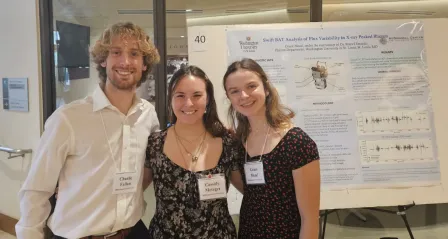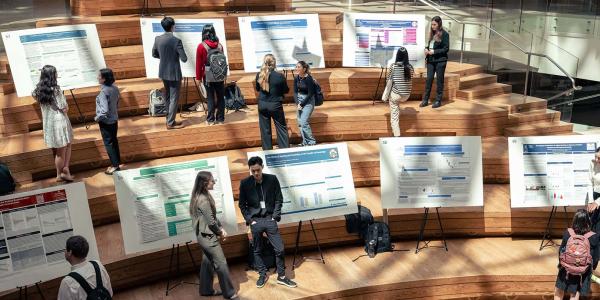The McDonnell Center for the Space Sciences provided support through undergraduate summer research fellowships to nine students in the summer of 2023.
Several of those students presented their research during the fall 2023 Undergraduate Research Symposium, held October 27 in Brauer Hall. The symposium showcased the diverse range of research, creative and experiential learning projects conducted by WashU undergraduate students and mentored by WashU faculty. It provided an important opportunity for undergraduate students to share their research, engage in peer networking and cross-disciplinary conversations, and develop presentation skills.

Charlie Fallon, Grace Mead, and Cassidy Metzger all worked with Manel Errando, assistant professor of physics and fellow of the McDonnell Center for the Space Sciences, during the summer of 2023. Fallon's poster, "Optimizing Gamma Detector Geometries for Astrophysics and Planetary Science," described the significance of gamma radiation in nuclear astrophysics and planetary science. Mead's poster, "Swift BAT Analysis of Flux Variability in X-ray Peaked Blazars," explains how observation data of blazars was processed.
Metzger's PowerPoint presentation, "Searching for TeV-emitting BL Lac: Utilizing WISE data to search for objects with the eROSITA data set," was delivered as an oral presentation. Her project aims to develop an algorithm that will search through the eROSITA catalog for objects that match the classification necessary to be described as TeV-emitting BL Lac sources with the aim of expanding the database of knowledge that surrounds BL Lac sources and their emissions.
Tomás Salazar worked with Alex Chen, assistant professor of physics and fellow of the McDonnell Center for the Space Sciences. Salazar's poster, "The Current Sheet Model: Modeling Gamma-Ray Emission from a Neutron Star," detailed his research with pulsars over the summer. Starting from the numerical simulation results, he traced the trajectory of emitted gamma-ray photons as a pulsar rotates in real time. He then mapped the arrival time of these photons at the Large Array Telescope (LAT) aboard Fermi.
In addition to the students who presented their research at the symposium, Matthew Yu (Philip Skemer), George Kingsland (Alexander Bradley), Chris Mobley (William Smith), William Labrador (Brian Rauch), and Nolan Schmidt (Jeffrey Gillis-Davis) received MCSS fellowships to support their research last summer.


